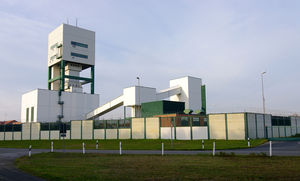
 |
| Fig. 1: Nuclear Salt Dome. (Source: Wikimedia Commons) |
Currently, nuclear waste management is expensive, dangerous and contaminates large areas. The most often used strategy to date is to bury the waste. Different nuclear companies have investigated space disposal and oceanic disposal but as of now, determined these strategies weren't feasible. Space disposal is expensive and has the potential for a catastrophic failure of launch vehicle. Ocean disposal has been halted by political disagreements and worry of contamination.
A strategy that I am proposing as the future for nuclear waste management is burying the waste in salt mines. The salt mines help contain the contamination and speed up the decomposition process. [1] Furthermore, because this method doesn't require any new technology it is something that could be implemented immediately and already exists on a small scale. One drawback is that there aren't that many salt mines in the United States that would work for this purpose. [1]
In the long-run, we will likely need other methods considering that the number of feasible salt mines are limited. Also, as space technology becomes safer and more affordable eliminating nuclear waste from the planet entirely sounds more enticing.
© Matthew DeGraw. The author grants permission to copy, distribute and display this work in unaltered form, with attribution to the author, for noncommercial purposes only. All other rights, including commercial rights, are reserved to the author.
[1] M. L. Wald, "Nuclear Waste Solution Seen in Desert Salt Beds," New York Times, 9 Feb 14